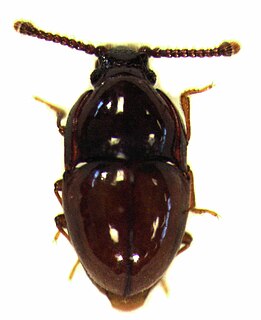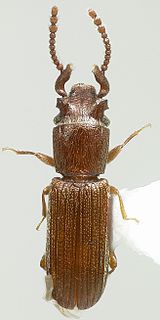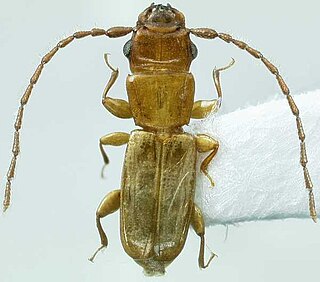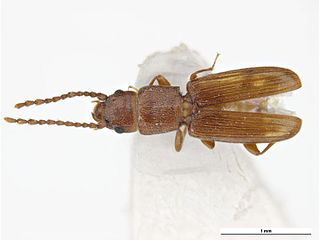| Cryptolestes | |
|---|---|
 | |
| Cryptolestes klapperichi | |
| Scientific classification | |
| Kingdom: | Animalia |
| Phylum: | Euarthropoda |
| Class: | Insecta |
| Order: | Coleoptera |
| Family: | Laemophloeidae |
| Genus: | Cryptolestes Ganglbauer, 1899 |
| Wikimedia Commons has media related to Cryptolestes . |
Cryptolestes is a genus of beetles in the family Laemophloeidae. Several species are known as economically important pests of stored products, especially food grains. The four most notorious species are Cryptolestes ferrugineus , Cryptolestes pusilloides , Cryptolestes pusillus , and Cryptolestes turcicus . [1] C. capensis, C. klapperichi, and C. ugandae are less widespread pests. [1] Species in this genus can be hard to distinguish from one another, and definitive identification often requires close examination of the genitalia. [2]
A genus is a taxonomic rank used in the biological classification of living and fossil organisms, as well as viruses, in biology. In the hierarchy of biological classification, genus comes above species and below family. In binomial nomenclature, the genus name forms the first part of the binomial species name for each species within the genus.

Beetles are a group of insects that form the order Coleoptera, in the superorder Endopterygota. Their front pair of wings are hardened into wing-cases, elytra, distinguishing them from most other insects. The Coleoptera, with about 400,000 species, is the largest of all orders, constituting almost 40% of described insects and 25% of all known animal life-forms; new species are discovered frequently. The largest of all families, the Curculionidae (weevils) with some 70,000 member species, belongs to this order. Found in almost every habitat except the sea and the polar regions, they interact with their ecosystems in several ways: beetles often feed on plants and fungi, break down animal and plant debris, and eat other invertebrates. Some species are serious agricultural pests, such as the Colorado potato beetle, while others such as Coccinellidae eat aphids, scale insects, thrips, and other plant-sucking insects that damage crops.

Laemophloeidae, "lined flat bark beetles," is a family in the superfamily Cucujoidea characterized by predominantly dorso-ventrally compressed bodies, head and pronotal discs bordered by ridges or grooves, and inverted male genitalia. Size range of adults is 1–5 mm (0.04–0.2 in) in length. Currently, it contains 40 genera and about 450 species, and is represented on all continents except Antarctica; species richness is greatest in the tropics.
Species include: [3]



- Cryptolestes abietis Wankowicz
- Cryptolestes ampiyacus Thomas
- Cryptolestes atuloides Lefkovitch
- Cryptolestes atulus Lefkovitch
- Cryptolestes beccarii Grouvelle
- Cryptolestes bicolor Chevrolat
- Cryptolestes biskrensis Grouvelle
- Cryptolestes brunneus Lefkovitch
- Cryptolestes calabozus Thomas
- Cryptolestes candius Lefkovitch
- Cryptolestes capensis Waltl
- Cryptolestes capillulus Thomas
- Cryptolestes cornutus Thomas & Zimmerman
- Cryptolestes corticinus Erichson
- Cryptolestes curus Lefkovitch
- Cryptolestes diemenensis Blackburn
- Cryptolestes divaricatus Grouvelle
- Cryptolestes duplicatus Waltl
- Cryptolestes dybasi Thomas
- Cryptolestes evansi Lefkovitch
- Cryptolestes fauveli Grouvelle
- Cryptolestes ferrugineus Stephens– rusty grain beetle
- Cryptolestes fractipennis Motschulsky
- Cryptolestes fursovi Iablokoff-Khnzorian
- Cryptolestes halevyae Thomas
- Cryptolestes incertus Grouvelle
- Cryptolestes inyoensis [4]
- Cryptolestes klapperichi Lefkovitch
- Cryptolestes lepesmei Villiers
- Cryptolestes mexicanus Thomas
- Cryptolestes minimus Lefkovitch
- Cryptolestes obesus [4]
- Cryptolestes planulatus Grouvelle
- Cryptolestes pubescens Casey
- Cryptolestes punctatus LeConte
- Cryptolestes pusilloides Steel & Howe
- Cryptolestes pusillus Schonherr– flat grain beetle
- Cryptolestes robinclarkei [5]
- Cryptolestes schwarzi Casey
- Cryptolestes spartii Curtis
- Cryptolestes spatulifer Thomas
- Cryptolestes spectabilis [4]
- Cryptolestes trinidadensis Thomas
- Cryptolestes turcicus Grouvelle– flour mill beetle
- Cryptolestes turnbowi [4]
- Cryptolestes ugandae Steel & Howe
- Cryptolestes uncicornis Reitter
- Cryptolestes weisei Reitter

Cryptolestes ferrugineus is a species of lined flat bark beetle native to Europe.
Cryptolestes punctatus is a species of lined flat bark beetle in the family Laemophloeidae. It is found in North America.

Cryptolestes pusillus is a species of lined flat bark beetle native to Europe. It is also known as the flat grain beetle. It feeds on grain products, and is considered a pest in Canada.












